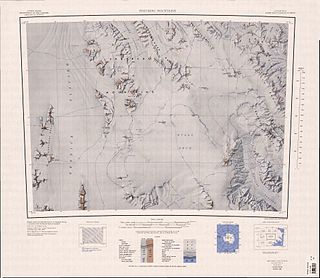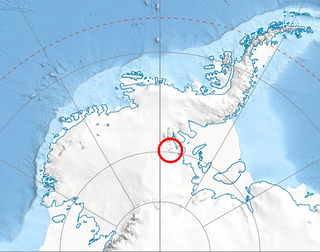Related Research Articles
The Queen Elizabeth Range is a rugged mountain range of the Transantarctic Mountains System, located in the Ross Dependency region of Antarctica.
The Forrestal Range is a largely snow-covered mountain range, about 105 km (65 mi) long, standing east of Dufek Massif and the Neptune Range in the Pensacola Mountains of Antarctica. Discovered and photographed on 13 January 1956 on a transcontinental patrol plane flight of U.S. Navy Operation Deep Freeze I from McMurdo Sound to the vicinity of the Weddell Sea and return.
The Churchill Mountains are a mountain range group of the Transantarctic Mountains System, located in the Ross Dependency region of Antarctica. They border on the western side of the Ross Ice Shelf, between Byrd Glacier and Nimrod Glacier.
The Dominion Range is a broad mountain range, about 48 km (30 mi) long, forming a prominent salient at the juncture of the Beardmore and Mill glaciers in Antarctica. The range is part of the Queen Maud Mountains
The Ford Ranges are a grouping of mountain ranges standing east of Sulzberger Ice Shelf and Block Bay in the northwest part of Marie Byrd Land, Antarctica. Discovered by the Byrd Antarctic Expedition on December 5, 1929, they were named by Byrd for Edsel Ford of the Ford Motor Company, who helped finance the expedition.
The Whitmore Mountains are an isolated mountain range of the Transantarctic Mountains System, located in the Marie Byrd Land region of West Antarctica.

Bellisime Glacier is a glacier about 4 nautical miles (7 km) long flowing south from Thurston Island east of Myers Glacier. It was named by the Advisory Committee on Antarctic Names after Lynda B. Bellisime of the United States Geological Survey (USGS), Flagstaff, Arizona, part of the USGS team that compiled the 1:5,000,000-scale Advanced Very High Resolution Radiometer maps of Antarctica and the 1:250,000-scale Landsat TM image maps of the Siple Coast area in the 1990s.
The Gothic Mountains is a group of mountains, 32 kilometres (20 mi) long, in the Queen Maud Mountains of Antarctica, located west of Watson Escarpment and bounded by Scott Glacier, Albanus Glacier, and Griffith Glacier. The mountains were first visited in December 1934 by the Byrd Antarctic Expedition (ByrdAE) geological party led by Quin Blackburn. The name was proposed by Edmund Stump, leader of a U.S. Antarctic Research Program (USARP) - Arizona State University geological party which made investigations here in the 1980-81 season. The mountains are composed of granites which have weathered to produce a series of spires and peaks reminiscent of a Gothic cathedral.

The Freyberg Mountains are a group of mountains in Victoria Land, Antarctica, bounded by Rennick Glacier, Bowers Mountains, Black Glacier, and Evans Neve. Named for New Zealand's most famous General, Lord Bernard Freyberg, by the Northern Party of New Zealand Geological Survey Antarctic Expedition (NZGSAE), 1963-64. This mountain group includes the Alamein Range. These topographical features all lie situated on the Pennell Coast, a portion of Antarctica lying between Cape Williams and Cape Adare.

Mount Feury is a mountain between Sikorski Glacier and Frankenfield Glacier on the northeast side of Noville Peninsula, Thurston Island. It was first delineated from air photos taken by U.S. Navy Operation Highjump in December 1946, and was named by the Advisory Committee on Antarctic Names for James Feury, a mechanic and snowmobile driver of the Byrd Antarctic Expedition, 1928–30.
Gallup Glacier is a broad glacier, about 12 nautical miles (22 km) long, flowing east between Mount Rosenwald and Mount Black to enter Shackleton Glacier, Antarctica, just north of Matador Mountain. It was named by the Advisory Committee on Antarctic Names after Commander F.S. Gallup, Jr., U.S. Navy, Commanding Officer of Squadron VX-6 during Operation Deep Freeze 1965.
Mount Gardiner is a ridge-like granitic mountain, 2,480 metres (8,140 ft) high, standing 3 nautical miles (6 km) east of Mount Ruth and just south of the junction of Bartlett Glacier and Scott Glacier, in the Queen Maud Mountains of Antarctica. It was discovered in December 1934 by the Byrd Antarctic Expedition geological party under Quin Blackburn, and named by Richard E. Byrd for Joseph T. Gardiner of Wellington, New Zealand, agent for the Byrd Antarctic Expeditions of 1928–30 and 1933–35.

Mount Morris is a steep, sharp mountain about 1 nautical mile (2 km) south of Mount Ostenso, in the main ridge of the Sentinel Range of the Ellsworth Mountains in Antarctica. It surmounts Patton Glacier to the eas-northeast.
Mendenhall Peak is a peak, 2,130 metres (7,000 ft) high, standing 0.5 nautical miles (0.9 km) west of Mount Wrather in the eastern part of the Thiel Mountains of Antarctica. The name, proposed by Peter Bermel and Arthur B. Ford, co-leaders of the United States Geological Survey (USGS) Thiel Mountains party which surveyed these mountains in 1960–61, is for Walter C. Mendenhall, who was, from 1931 to 1943, the fifth director of the USGS.
Mount Huffman is a prominent mountain 4 nautical miles (7 km) northeast of Mount Abrams, in the Behrendt Mountains of Ellsworth Land, Antarctica. It was mapped by the United States Geological Survey from surveys and U.S. Navy air photos from 1961 to 1967, and was named by the Advisory Committee on Antarctic Names for Jerry W. Huffman, a scientific leader at Eights Station in 1963.
The Marble Hills are a group of mainly ice-free hills in West Antarctica. They are located on the west side of Horseshoe Valley, between the Liberty Hills and Independence Hills in the southern part of the Heritage Range, Ellsworth Mountains. The hills were named by the University of Minnesota Ellsworth Mountains Party, 1962–63, because the rocks in these hills are composed of marble.
Mount Hoffman is a distinctive rock peak 1.5 nautical miles (3 km) south-southwest of Mount Tidd, in the southern flank of the Pirrit Hills of Antarctica. The peak was positioned by the U.S. Ellsworth–Byrd Traverse Party on December 7, 1958, and was named for Daniel Hoffman, a mechanic with the traverse party.
The Lance Rocks are two rocks lying together at the northeast end of Crouse Spur in the Forrestal Range, Pensacola Mountains, Antarctica. They were mapped by the United States Geological Survey from surveys and U.S. Navy air photos, 1956–66, and were named by the Advisory Committee on Antarctic Names for Captain Samuel J. Lance, United States Air Force, navigator and member of the Electronic Test Unit in the Pensacola Mountains, 1957–58.

The Liberty Hills are a line of rugged hills and peaks with bare rock eastern slopes, about 10 nautical miles (19 km) long, standing 7 nautical miles (13 km) northwest of the Marble Hills and forming part of the west wall of Horseshoe Valley, in the Heritage Range, Ellsworth Mountains, Antarctica. The Liberty Hills were mapped by the United States Geological Survey from ground surveys and U.S. Navy air photos, 1961–66. The name was applied by the Advisory Committee on Antarctic Names in association with the name Heritage Range. The remarkable High Nunatak towers east of the Hills.

Mount Hale is a mountain standing 1.5 mi NW of Mount Davis in the main ridge of the Sentinel Range, Antarctica. Discovered by the Marie Byrd Land Traverse party, 1957–58, under Charles R. Bentley, and named for Daniel P. Hale, auroral physicist at Byrd Station and member of the traverse party.
References
- ↑ "Fordell, Mount". Geographic Names Information System . United States Geological Survey, United States Department of the Interior . Retrieved 30 March 2012.
![]() This article incorporates public domain material from "Fordell, Mount". Geographic Names Information System . United States Geological Survey.
This article incorporates public domain material from "Fordell, Mount". Geographic Names Information System . United States Geological Survey.
